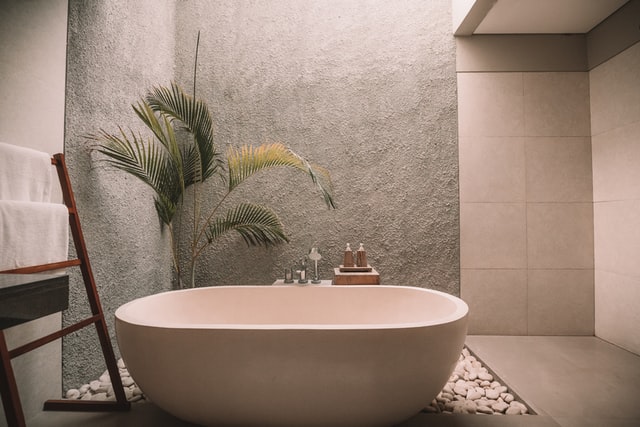Mould or mildew is often found in the bathroom, since it is generally humid. Mould is not only ugly, but also harmful if left untreated for an extended length of time. So, how can one get rid of mould in the bathroom and prevent it from recurring? Let’s see what we can learn.

How to Spot the Bathroom Mould?
There exist uncountable forms and colours of moulds. Even though Stachybotrys, a black mould, gets a bad rap for its toxicity, any mould detected in your home poses a threat to your health and should be eradicated as soon as you find it. Black mould is more likely to be found in the bathroom around drains and on walls or wallpaper, as well as in the grout between tile and grout.
Smell your bathroom to see whether there’s black mould growing there. The musty, stagnant stink of black mould in showers is apparent. Loofahs, shampoo bottles, stains and any standing water are all afflicted by this decaying odour. Early mould development is evident by the presence of black stains or pink patches in certain locations.
If you can smell mould but can’t see it, check for mould in bathroom in hidden locations such as beneath sinks, toilets and baths, behind doors, under shower fixtures and screens, crawlspaces, exhaust fans and shower curtains. It might start in the bathroom and spread to other areas undetected. Mould is better avoided than treated, since it may become a significant issue once it spreads.
The Reasons for Mould Infestation in the Bathroom
Because of the high relative humidity and wetness, bathrooms are common places where mould may thrive. Condensation is formed on walls, ceilings and tiles as a result of the steam created by flowing warm water from the shower, bath or sink. Other wet parts of the house, such as the kitchen, basement, and outbuildings, are also typical breeding grounds for mould. In bathrooms with inadequate ventilation, mould growth is more likely. When the steam from hot water settles on the walls and ceiling of your bathroom, it may trickle down and harm tiles, grout and windows when it cools down.
Is There a Sure Shot Way to Get Rid of Mould?
Any mouldy grout or sealant should be stripped away and replaced. Mould-killing agents like vinegar and hydrogen peroxide can clean the bathroom. These items should not be mixed since they are hazardous. Mould is also resistant to soap and water. Here is how you can get rid of mould:
- While cleaning, open doors and windows to let fresh air in and allow the mould to dry off.
- When cleaning, use protective gloves and aprons and avoid allowing materials to contact a person’s skin.
- Use anti-mould sprays sparingly and keep spaces adequately aired and kids out of the bathroom.
- Because the spores can bring the mould back, it’s preferable to destroy it first and then remove it.
- If the mould spreads to the walls, one should get expert help immediately because this might be a long-term issue.
What Not to Do When Removing Mould?
If you don’t know what you’re doing when it comes to dealing with mould, it may be quite difficult to remove it. Fortunately, you can avoid making mistakes after knowing this:
- Discolouration and spores are left behind after bleaching mould, which does not destroy the mould itself.
- Applying “mould-resistant” paint over mould-infested surfaces does not destroy the mould and might instead create additional problems in the long term.
- Even if you successfully eliminate mould, it will return if the space is wet and poorly aired or if there is extra moisture from a leak.
How to Keep the Bathroom Free of Mould in the Future?
- While showering or bathing, use a ventilation fan in the bathroom and leave it running for 30 minutes after you are done. Keeping windows open after the shower can also help.
- Use air conditioning or dehumidifiers to keep humidity levels low. Humidity levels should be below 50%.
- Install a shower screen or enclosure or use a mildew-resistant shower curtain.
- Bathroom rugs should be cleaned regularly. Wet towels and carpets should be hung in well-ventilated spaces.
- Clean and dry the bathroom more often.
- Wipe away excess water with an old towel or a squeegee after a shower or bath to prevent it from sinking in.
- Allow for complete drying of the shower curtain by stretching it out to its perfect length.
- Instead of fragrant curtains and rugs, use sanitisers.
- If feasible, use gloss paint since it generates a tougher surface that inhibits mould development.
On the Whole
One must keep the bathroom well-ventilated and well-lit with natural light to cope with and avoid mould. After a shower, completely dry all damp surfaces, including the crevices, in order to prevent the growth of mould. Tiles must be cleaned regularly and treated with the solutions mentioned above to prevent infestation in the future.
Mould is a nightmare for any household. It is a health risk and an eyesore, and if not addressed quickly, it may quickly spread. However, now that you have all the information you require to combat mould, put it to use, and your bathroom will once again be a safe place.
Leave a Reply